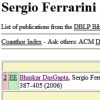| |
   
Bhaskar DasGupta,
Sergio Ferrarini,
Uthra Gopalakrishnan and
Nisha Raj Paryani. Inapproximability results for the lateral gene transfer problem. In JCO, Vol. 11(4):387-405, 2006.
Keywords: approximation, from rooted trees, from species tree, inapproximability, lateral gene transfer, parsimony, phylogenetic network, phylogeny.
Note: http://www.cs.uic.edu/~dasgupta/resume/publ/papers/t-scenario-3-reviewed-3.pdf.
|
|
| |
 
Vincent Moulton and
Katharina Huber. Phylogenetic networks from multi-labelled trees. In JOMB, Vol. 52(5):613-632, 2006.
Keywords: duplication, explicit network, from multilabeled tree, phylogenetic network, phylogeny, Program PADRE, reconstruction.
Note: http://www.uea.ac.uk/~a043878/jmb.pdf.
Toggle abstract
"It is now quite well accepted that the evolutionary past of certain species is better represented by phylogenetic networks as opposed to trees. For example, polyploids are typically thought to have resulted through hybridization and duplication, processes that are probably not best represented as bifurcating speciation events. Based on the knowledge of a multi-labelled tree relating collection of polyploids, we present a canonical construction of a phylogenetic network that exhibits the tree. In addition, we prove that the resulting network is in some well-defined sense a minimal network having this property. © Springer-Verlag 2006."
|
|
| |
 
Daniel H. Huson and
David Bryant. Application of Phylogenetic Networks in Evolutionary Studies. In MBE, Vol. 23(2):254-267, 2006.
Keywords: abstract network, phylogenetic network, phylogeny, Program SplitsTree, software, survey.
Note: http://dx.doi.org/10.1093/molbev/msj030, software available from www.splitstree.org.
Toggle abstract
"The evolutionary history of a set of taxa is usually represented by a phylogenetic tree, and this model has greatly facilitated the discussion and testing of hypotheses. However, it is well known that more complex evolutionary scenarios are poorly described by such models. Further, even when evolution proceeds in a tree-like manner, analysis of the data may not be best served by using methods that enforce a tree structure but rather by a richer visualization of the data to evaluate its properties, at least as an essential first step. Thus, phylogenetic networks should be employed when reticulate events such as hybridization, horizontal gene transfer, recombination, or gene duplication and loss are believed to be involved, and, even in the absence of such events, phylogenetic networks have a useful role to play. This article reviews the terminology used for phylogenetic networks and covers both split networks and reticulate networks, how they are defined, and how they can be interpreted. Additionally, the article outlines the beginnings of a comprehensive statistical framework for applying split network methods. We show how split networks can represent confidence sets of trees and introduce a conservative statistical test for whether the conflicting signal in a network is treelike. Finally, this article describes a new program, SplitsTree4, an interactive and comprehensive tool for inferring different types of phylogenetic networks from sequences, distances, and trees. © The Author 2005. Published by Oxford University Press on behalf of the Society for Molecular Biology and Evolution. All rights reserved."
|
|
| |
|
| |
  
Jesper Jansson,
Nguyen Bao Nguyen and
Wing-Kin Sung. Algorithms for Combining Rooted Triplets into a Galled Phylogenetic Network. In SICOMP, Vol. 35(5):1098-1121, 2006.
Keywords: approximation, explicit network, from triplets, galled tree, phylogenetic network, phylogeny, polynomial, reconstruction.
Note: http://www.df.lth.se/~jj/Publications/triplets_to_gn7_SICOMP2006.pdf.
Toggle abstract
"This paper considers the problem of determining whether a given set Τ of rooted triplets can be merged without conflicts into a galled phylogenetic network and, if so, constructing such a network. When the input Τ is dense, we solve the problem in O(|Τ|) time, which is optimal since the size of the input is Θ(|Τ|). In comparison, the previously fastest algorithm for this problem runs in O(|Τ|2) time. We also develop an optimal O(|Τ|)-time algorithm for enumerating all simple phylogenetic networks leaf-labeled by L that are consistent with Τ, where L is the set of leaf labels in Τ, which is used by our main algorithm. Next, we prove that the problem becomes NP-hard if extended to nondense inputs, even for the special case of simple phylogenetic networks. We also show that for every positive integer n, there exists some set Τ of rooted triplets on n leaves such that any galled network can be consistent with at most 0.4883 ·|Τ| of the rooted triplets in Τ. On the other hand, we provide a polynomial-time approximation algorithm that always outputs a galled network consistent with at least a factor of 5/12 (> 0.4166) of the rooted triplets in Τ. © 2006 Society for Industrial and Applied Mathematics."
|
|
| |
  
Mihaela Baroni,
Charles Semple and
Mike Steel. Hybrids in Real Time. In Systematic Biology, Vol. 55(1):46-56, 2006.
Keywords: agreement forest, from rooted trees, phylogenetic network, phylogeny, polynomial, reconstruction, time consistent network.
Note: http://www.math.canterbury.ac.nz/~m.steel/Non_UC/files/research/hybrids.pdf.
Toggle abstract
"We describe some new and recent results that allow for the analysis and representation of reticulate evolution by nontree networks. In particular, we (1) present a simple result to show that, despite the presence of reticulation, there is always a well-defined underlying tree that corresponds to those parts of life that do not have a history of reticulation; (2) describe and apply new theory for determining the smallest number of hybridization events required to explain conflicting gene trees; and (3) present a new algorithm to determine whether an arbitrary rooted network can be realized by contemporaneous reticulation events. We illustrate these results with examples. Copyright © Society of Systematic Biologists."
|
|
| |
 
Sergey Bereg and
Yuanyi Zhang. Phylogenetic Networks Based on the Molecular Clock Hypothesis. In TCBB, Vol. 3(4), 2006.
Note: http://www.utdallas.edu/~yzhang/Homepage/Papers/prep-tcbb.pdf.
Toggle abstract
A classical result in phylogenetic trees is that a binary phylogenetic tree adhering to the molecular clock hypothesis exists if and only if the matrix of distances between taxa is ultrametric. The ultrametric condition is very restrictive. In this paper we study phylogenetic networks that can be constructed assuming the molecular clock hypothesis. We characterize distance matrices that admit such networks for 3 and 4 taxa. We also design two algorithms for constructing networks optimizing the least-squares fit.
|
|
| |
|
| |
|
| |
 
Jesper Jansson and
Wing-Kin Sung. Inferring a level-1 phylogenetic network from a dense set of rooted triplets. In TCS, Vol. 363(1):60-68, 2006.
Keywords: explicit network, from triplets, galled tree, level k phylogenetic network, phylogenetic network, phylogeny, polynomial, reconstruction.
Note: http://www.df.lth.se/~jj/Publications/ipnrt8_TCS2006.pdf.
Toggle abstract
"We consider the following problem: Given a set T of rooted triplets with leaf set L, determine whether there exists a phylogenetic network consistent with T, and if so, construct one. We show that if no restrictions are placed on the hybrid nodes in the solution, the problem is trivially solved in polynomial time by a simple sorting network-based construction. For the more interesting (and biologically more motivated) case where the solution is required to be a level-1 phylogenetic network, we present an algorithm solving the problem in O (| T |2) time when T is dense, i.e., when T contains at least one rooted triplet for each cardinality three subset of L. We also give an O (| T |5 / 3)-time algorithm for finding the set of all phylogenetic networks having a single hybrid node attached to exactly one leaf (and having no other hybrid nodes) that are consistent with a given dense set of rooted triplets. © 2006 Elsevier B.V. All rights reserved."
|
|
| |
|
| |
|
| |
|
| |

Derek Ruths. Applications of phylogenetic incongruence to detecting and reconstructing interspecific recombination and horizontal gene transfer. Master's thesis, Rice University, U.S.A., 2005.
Keywords: explicit network, from rooted trees, from species tree, heuristic, phylogenetic network, phylogeny, polynomial, reconstruction.
Note: http://hdl.handle.net/1911/17912.
|
|
| |

David Bryant. Extending tree models to splits networks. In
Lior Pachter and
Bernd Sturmfels editors, Algebraic Statistics for Computational Biology, Pages 322-334, Cambridge University Press, 2005.
Keywords: abstract network, from splits, likelihood, phylogenetic network, phylogeny, split, split network, statistical model.
Note: http://www.math.auckland.ac.nz/~bryant/Papers/05ascbChapter.pdf.
|
|
| |
|
| |
 
Sergey Bereg and
Kathryn Bean. Constructing Phylogenetic Networks from Trees. In BIBE05, Pages 299-305, 2005.
Keywords: evaluation, from distances, phylogenetic network, phylogeny, Program SplitsTree, Program T REX, reconstruction, split, split network.
Note: http://dx.doi.org/10.1109/BIBE.2005.19.
Toggle abstract
We present a new method of constructing a phylogenetic network from a given phylogenetic tree. It is based on a procedure that locally improves the tree. The procedure is quite general and can be applied to phylogenetic networks. By repeating local improvements user can introduce a given number of recombination cycles. A sequence of networks with decreasing distance deviation can be generated. The algorithm is efficient and shows a good performance on an example with plants. This is due to the fact that the update in every step is local and optimal. © 2005 IEEE.
|
|
| |
 
Sergey Bereg and
Yuanyi Zhang. Phylogenetic Networks Based on the Molecular Clock Hypothesis. In BIBE05, Pages 320-323, 2005.
Note: http://dx.doi.org/10.1109/BIBE.2005.46.
Toggle abstract
A classical result in phylogenetic trees is that a binary phylogenetic tree adhering to the molecular clock hypothesis exists if and only if the matrix of distances between taxa is ultrametric. The ultrametric condition is very restrictive. In this paper we study phylogenetic networks that can be constructed assuming the molecular clock hypothesis. We characterize distance matrices that admit such networks for 3 and 4 taxa. We design an efficient algorithm for a special class of phylogenetic networks that can detect the existence of a network and constructs it. © 2005 IEEE.
|
|
| |
|
| |
|
| |
 
Daniel H. Huson and
Tobias Kloepper. Computing recombination networks from binary sequences. In ECCB05, Vol. 21(suppl. 2):ii159-ii165 of BIO, 2005.
Keywords: from sequences, phylogenetic network, phylogeny, recombination.
Note: http://dx.doi.org/10.1093/bioinformatics/bti1126.
Toggle abstract
"Motivation:Phylogenetic networks are becoming an important tool in molecular evolution, as the evolutionary role of reticulate events, such as hybridization, horizontal gene transfer and recombination, is becoming more evident, and as the available data is dramatically increasing in quantity and quality. Results: This paper addresses the problem of computing a most parsimonious recombination network for an alignment of binary sequences that are assumed to have arisen under the 'infinite sites' model of evolution with recombinations. Using the concept of a splits network as the underlying datastructure, this paper shows how a recent method designed for the computation of hybridization networks can be extended to also compute recombination networks. A robust implementation of the approach is provided and is illustrated using a number of real biological datasets. © The Author 2005. Published by Oxford University Press. All rights reserved."
|
|
| |
|
| |
|
| |
|
| |
  
Yun S. Song,
Yufeng Wu and
Dan Gusfield. Efficient computation of close lower and upper bounds on the minimum number of recombinations in biological sequence evolution. In ISMB05, Vol. 21:i413-i422 of BIO, 2005.
Keywords: integer linear programming, minimum number, Program HapBound, Program SHRUB, recombination.
Note: http://dx.doi.org/10.1093/bioinformatics/bti1033.
Toggle abstract
"Motivation: We are interested in studying the evolution of DNA single nucleotide polymorphism sequences which have undergone (meiotic) recombination. For a given set of sequences, computing the minimum number of recombinations needed to explain the sequences (with one mutation per site) is a standard question of interest, but it has been shown to be NP-hard, and previous algorithms that compute it exactly work either only on very small datasets or on problems with special structure. Results: In this paper, we present efficient, practical methods for computing both upper and lower bounds on the minimum number of needed recombinations, and for constructing evolutionary histories that explain the input sequences. We study in detail the efficiency and accuracy of these algorithms on both simulated and real data sets. The algorithms produce very close upper and lower bounds, which match exactly in a surprisingly wide range of data. Thus, with the use of new, very effective lower bounding methods and an efficient algorithm for computing upper bounds, this approach allows the efficient, exact computation of the minimum number of needed recombinations, with high frequency in a large range of data. When upper and lower bounds match, evolutionary histories found by our algorithm correspond to the most parsimonious histories. © The Author 2005. Published by Oxford University Press. All rights reserved."
|
|
| |
 
Luay Nakhleh and
Li-San Wang. Phylogenetic Networks, Trees, and Clusters. In IWBRA05, Vol. 3515:919-926 of LNCS, springer, 2005.
Keywords: cluster containment, evaluation, from clusters, from network, from rooted trees, phylogenetic network, phylogeny, polynomial, tree containment, tree-child network.
Note: http://www.cs.rice.edu/~nakhleh/Papers/NakhlehWang.pdf.
|
|
| |
|
| |
|
| |
|
| |

Elena Dubrova. Phylogenetic networks with edge-disjoint recombination cycles. In Proceedings of SPIE Bioengineered and Bioinspired Systems II (SPIE-BBS II), Vol. 5839:381-388, 2005.
Keywords: galled tree, phylogenetic network, polynomial, site consistency.
Note: http://dx.doi.org/10.1117/12.607910.
Toggle abstract
"Phylogenetic analysis is a branch of biology that establishes the evolutionary relationships between living organisms. The goal of phylogenetic analysis is to determine the order and approximate timing of speciation events in the evolution of a given set of species. Phylogenetic networks allow to represent evolutionary histories that include events like recombination and hybridization. In this paper, we introduce a class of phylogenetic networks called extended galled-trees in which recombination cycles share no edge. We show that the site consistency problem, which is NP-hard in general, can be solved in polynomial time for this class of phylogenetic networks."
|
|
|